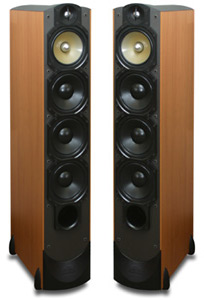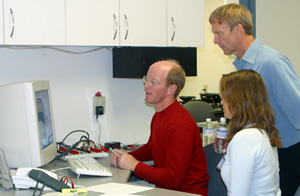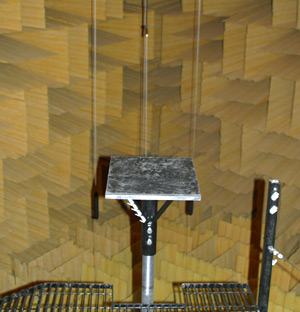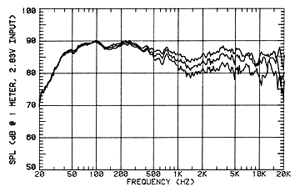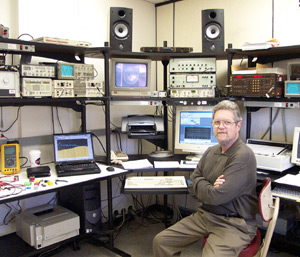![[SoundStage!]](../sslogo3.gif) Getting Technical Getting TechnicalBack-Issue Article |
|||
December 2003
Loudspeaker Dispersion: Introduction to a Challenging Design Problem Back in the day when my dad brought home his new speakers, he spent an afternoon moving them -- and his brown La-Z-Boy -- around the living room. He was looking for the sweet spot, and he found it. Move a step to the left or right of that La-Z-Boy, and you immediately heard the difference. On the other hand, we never moved the piano, and there was no sweet spot for my grandma to sit in. It sounded the same throughout the room. Like all musical instruments, pianos are able to fill a room with sound -- or even an entire house, which can be unfortunate. To this day, I am haunted by the sound of my mother's voice from the kitchen during my practice hour: "I can't hear the piano!" Why loudspeakers don't act like pianos is all about dispersion. Musical instruments emit sound waves differently than speakers, and these sound waves bounce off the walls, the ceiling, and furniture creating different radiation patterns. Because our sense of hearing can easily detect these differing patterns in sound, loudspeaker dispersion is one of top three concerns of speaker design, along with low distortion and flat frequency response. Recently, I had the opportunity to discuss dispersion with two leaders in loudspeaker design: Scott Bagby, head of research and development at Paradigm Loudspeakers, and Paul Barton, founder and chief designer of PSB Speakers. The room counts Before we discuss dispersion, it is important to understand what occurs inside your typical room. Sound waves interacting with the environment create three types of sound. There is the direct sound, and then there are two types of indirect sound: reflected and reverberant. Only about 30% of what we hear comes from the direct sound. This sound reaches our brain first and is used to localize and recognize the sound. The remaining 70% is the reflected and reverberant sound that is created from the sound waves radiating out from the speakers, bouncing off objects, and eventually reaching the brain. Reflected and reverberant sound provide the brain with the perception of the sound's characteristic -- its musicality, spaciousness, tonality, and color. Therefore, the way the sound radiates, or disperses, from a speaker is important for great sound; the greater and more evenly the loudspeaker can disperse its sound, generally the better that speaker sounds in a real-room setting. How dispersion is measured: Paradigm
In the '70s and '80s, researchers at Canada's National Research Council (NRC) discovered that a speaker's direct and indirect sound were of equal importance -- a speaker must perform well in terms of on-axis frequency response (direct sound) as well as off-axis frequency response (indirect sound). So the NRC developed standard ways to measure speaker dispersion. This meant little to me even after staring at NRC graphs, so I visited Paradigm's state-of-the-art R&D facility in Mississauga to see exactly how loudspeaker dispersion is measured. Paradigm was one of the original companies involved with the NRC's groundbreaking research 20 years ago, and it was well worth the two-hour drive from my home base in London. Paradigm’s Scott Bagby along with marketing manager Mark Aling and product-design engineer Doug Coote showed me around, and in the process clarified my understanding of dispersion. Paradigm has its own 33,000-cubic-foot anechoic chamber, and it is impressive. You enter through a door and walk onto a catwalk, at the center of which a rotating speaker base is a dominant presence. In front of the base hangs a microphone, suspended from the ceiling. Every surface is covered by 7' long by 2' wide alternating tapered wedges of yellow fiberglass. Sound is absorbed so efficiently that as soon as I stepped inside it felt as if my ears were plugged. Anechoic chambers are considered to be the most accurate way to measure a loudspeaker's frequency response. Constructed to absorb all sounds, they ensure that the only sound reaching the microphone is that from the speaker. In this way, anechoic chambers effectively remove "the room" from the test. Everything is computer controlled by Paradigm’s own proprietary software created at Paradigm's Advanced Research Center (PARC) by Dr. Peter Schuck. This software allows for very fast and very accurate measurements and analysis of a speaker's properties. I sat down at the computer with Doug Coote while he demonstrated how he measures sound dispersion. The speaker is set up on the rotating base in the anechoic chamber and a swept-sine signal is digitally generated and sent through. The microphone picks up the speaker's response and sends it back to the computer where, almost instantly, a line on the frequency-response graph appears. "Ideally, you want a straight line because you want the signal to be perfectly duplicated by the speaker," says Doug. "The same input and output. Right now, that's impossible." This first measurement is on-axis, or the direct sound from the speaker. It is the reference point midway between the woofer and the tweeter and is referred to as the 0-degree measurement. The next is the "listening window," and is the measurement set in the area from 0 degrees to 15 degrees in front of the speaker vertically and horizontally. But, as Scott explains, these on-axis frequency-response measurements are not enough. "We do on- and off-axis measurements because on-axis does not give you the complete picture," he says. "We don't hear this way; we hear everything, including reflections and reverberant sounds." "There are three main windows we measure," continues Doug. "The on-axis window, which is 0 to 15 degrees; 30 to 45 degrees, which are the first reflections; and the 60 to 90 degrees, which make up the ambient sound field." Other summations of the speaker's on- and off-axis response are made to derive the front-hemisphere response (averaged from 0 to 90 degrees vertically and horizontally in all directions), as well as the total radiated power, or sound power, of the speaker (averaged from 0 to 180 degrees vertically and horizontally in all directions) -- something integral to the sonic character of the speaker in the listening room. The off-axis measurements begin at the 15-degree mark and occur every 15 degrees until the speaker has rotated 180 degrees left and right. The next step is to measure 180 degrees up and down in the same 15-degree increments. The computer is so efficient that it only takes minutes to measure the speaker's frequency response completely, on- and off-axis horizontally and vertically, and graphically display the results, which in the case of the demonstration indicates that the speaker being tested has the desired dispersion characteristics. That is, the measurements taken off-axis are similar to the on-axis measurements, which demonstrates that the sound that comes from the front of the speaker is the same as the sound that surrounds it. "How important is loudspeaker dispersion?" I ask Scott. "It's critical," he succinctly replies.
The difficulty with dispersion: PSB Speakers One would think that knowing that loudspeaker dispersion is critical to great sound and knowing how to measure for it would make designing speakers a snap. However, knowing the problem and correcting it are two different things. Over 30 years ago, Paul Barton was the first speaker designer to work with Floyd Toole at Canada's NRC. He discusses the difficulties with dispersion. "Directivity or dispersion of speakers was recognized as pretty important back in 1961 in an article called "Loudspeaker Testing in Rooms" by William B. Snow, published in in the Journal of the Audio Engineering Society [vol. 9, no. 1, pp. 54-60, January 1961]. Here we are in 2003 and we're still trying to get it right. I spend many hours working on just that issue -- trying to decide, based on measurements, how to best interpret how the speaker is going to interface in a room. And that's the question: What should the radiating pattern be from a speaker?" It's not an easy question to answer. Dispersion is complicated by the very nature of sound and the incredible acuity of human hearing. Our ears can easily perceive sounds that range from 20Hz to 20,000Hz. And since frequency is related to wavelength -- lower frequencies have longer wavelengths -- sounds with different frequencies disperse differently in a room. So when you are listening to music, there are multiple sound waves of different lengths that cause them to react differently throughout the room. Our perception of such a wide range of frequency constrains loudspeaker design. Large loudspeaker drivers (woofers, for example) cannot produce high frequencies and small loudspeaker drivers (tweeters) cannot produce low frequencies. For a speaker to emit sounds with frequencies ranging from 20Hz to 20,000Hz, the speaker therefore must have different-sized drivers -- at minimum a woofer and tweeter (a two-way speaker); or a woofer, midrange, and tweeter (a three-way speaker); or even more. Frequency also affects dispersion, as Paul explains. "If I place the microphone in the center of the speaker I only know how the sound disperses on-axis. I don't know how the dispersion is changing at other angles around the speaker. Even if a speaker has a great on-axis response, it will sound terrible if the dispersion is narrow. The reflected sound interferes with good, direct sound," he says. "But what I do know is that dispersion diminishes as frequency increases. As the wavelengths become very, very small and the dispersion gets narrower, the sound will begin to emit like a laser beam." This occurs because dispersion is dependent on the length of the wavelength relative to the radiator. If the wavelength is long relative to the size of the radiator, there will be good dispersion. Therefore, as the frequency the driver reproduces increases, its wavelength decreases until it is too short and then the driver will begin to "beam" the high-frequency sound. With a tweeter, beaming usually occurs at frequencies beyond our perception; however, with a midrange, the poor dispersion will be noticeable. And speakers with beaming problems will create "sweet spots" in the room. "We call this lobing," continues Paul. "For instance, you have a speaker with two drivers and a tweeter in the center, and these two drivers interact together at some frequency. If it happens to be a frequency that is proportional to the distance the drivers are apart, lobing occurs. Plotted on a circular curve, lobes have weird shapes -- flowers, butterflies -- you get very exotic interference patterns between two sources." Lobes occur off-axis and are large fluctuations in frequency response that cause poor sound for anyone not listening on-axis. When one sits off-axis he may be listening to the interference of lobing. This explains why my dad's speakers sounded best only when he sat in his La-Z-Boy -- everywhere else in the room was off-axis, and lobes were interfering with the speaker's sound. Paul says you can never completely eliminate lobing. "You can control it, and that's my challenge. I want to be able to choose the right distance between the drivers; I want to be able to choose what frequency range each driver produces so that this phenomena can be controlled and it has to be controlled in way that when the bounces are in a room that it's not a detriment to the overall sound of the speaker. This is very challenging because you think of electronics as a two-dimensional problem, where acoustics is a more complex three-dimensional problem." In a future column, "Loudspeaker Dispersion: Designing for Optimum Dispersion," I will discuss the various ways speaker companies have reduced lobing and are improving dispersion. ...Alison Aulph
|
|||
|
|||
![[SoundStage!]](../sslogo3.gif) All Contents All ContentsCopyright © 2003 SoundStage! All Rights Reserved |
